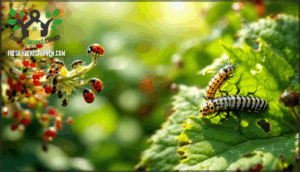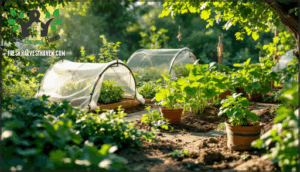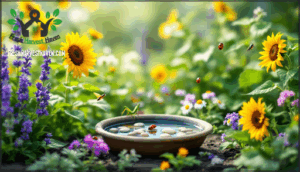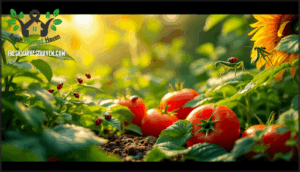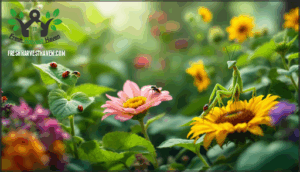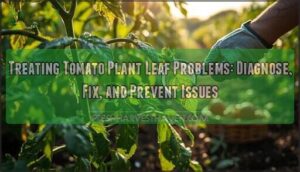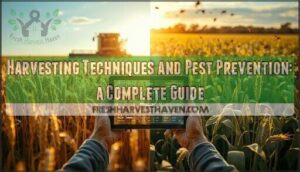This site is supported by our readers. We may earn a commission, at no cost to you, if you purchase through links.
 Every gardener knows the heartbreak of discovering a once-perfect tomato plant chewed ragged overnight. One minute, your lettuce leaves look lush; the next, they’re lacework for hungry caterpillars. But chemical quick-fixes come with a shadow—sick bees, disrupted soil life, lingering toxins.
Every gardener knows the heartbreak of discovering a once-perfect tomato plant chewed ragged overnight. One minute, your lettuce leaves look lush; the next, they’re lacework for hungry caterpillars. But chemical quick-fixes come with a shadow—sick bees, disrupted soil life, lingering toxins.
There’s a better way. When you lean into controlling garden insects naturally, you aren’t just saving your crops—you’re building a thriving, resilient patch that hums with pollinators and healthy life.
The magic lies in working with nature’s rhythms, not against them, and soon enough, your garden will reward you in ways you can see, taste, and feel.
Table Of Contents
- Key Takeaways
- Why Natural Pest Control Matters
- Recognizing Common Garden Pests
- Boosting Plant Health for Pest Resistance
- Using Physical Barriers for Protection
- Companion Planting for Pest Prevention
- Attracting Beneficial Insects Naturally
- Natural Pest Control Methods That Work
- Organic Sprays and Dusts for Pest Management
- Sustainable Garden Maintenance Practices
- Encouraging a Balanced Garden Ecosystem
- Frequently Asked Questions (FAQs)
- What home remedy kills bugs in a vegetable garden?
- What’s the best thing to keep bugs out of your garden?
- What is the best natural pest control for gardens?
- How do I stop bugs from eating my vegetables?
- Will vinegar keep bugs off garden plants?
- How do I identify beneficial insects from harmful ones?
- Whats the best timing for applying natural treatments?
- Can homemade sprays damage my vegetable plants?
- How often should I reapply organic pest controls?
- Which natural methods work for indoor plant pests?
- Conclusion
Key Takeaways
- Chemical pesticides cause 385 million yearly poisonings globally and kill 43% of bee populations in high-use areas, while natural methods protect beneficial insects, pollinators, and soil health without toxic residues.
- Strong plant health through compost, proper watering, and companion planting (like tomatoes with basil or carrots with onions) creates natural pest resistance that reduces the need for any interventions.
- Physical barriers like garden mesh, row covers, and strategic fencing provide immediate pest protection without chemicals, while attracting beneficial insects through native flowers and insect habitats builds long-term natural pest control.
- Simple organic methods like hand-picking pests, neem oil applications every 7-14 days, insecticidal soap sprays, and diatomaceous earth effectively manage infestations while maintaining garden ecosystem balance.
Why Natural Pest Control Matters
Chemical pesticides might seem like a quick fix, but they come with hidden costs to your health and the environment. Natural pest control protects your garden’s balance while keeping beneficial insects and pollinators safe.
Let’s look at three key reasons why going natural is worth your effort.
Risks of Chemical Pesticides
Chemical pesticides pose serious threats to your garden and beyond. While they promise quick fixes, the impact of pesticides extends far beyond target pests. Here’s what avoiding pesticide use protects you from:
- Human Poisonings – Globally, 385 million unintentional poisonings occur yearly, with 44% of farmers affected by insecticides and chemical pesticides.
- Chronic Exposure – Long-term use increases cancer risk by 30-41% and links to Parkinson’s disease and reproductive disorders.
- Environmental Impact – 80% of pesticides create toxic residues that contaminate soil and water for years.
- Biodiversity Loss – Bee populations drop 43% in high-use areas, threatening pollination of 75% of crops.
- Regulatory Gaps – Safety testing misses long-term effects on children and beneficial organisms.
These chemicals can cause acute and chronic health issues.
Benefits for Garden Ecosystems
Healthy garden ecosystems thrive when you skip harsh sprays and choose natural pest control. You’ll see more beneficial insects swooping in, richer soil that holds water better, and a steady boost in plant health over time.
Fewer chemicals mean your garden fosters ecosystem biodiversity and keeps water quality high—like nature meant, with every living thing playing its part.
You can also use companion planting methods to naturally repel pests.
Protecting Pollinators and Wildlife
When you work with nature instead of against it, your garden becomes a safe haven where bees, butterflies, and songbirds can do their thing without worry.
By growing native plants and skipping harsh sprays, you’re preserving habitats, offering bird baths or water sources, and giving wildlife—especially pollinators and beneficial insects—a chance to thrive.
That’s organic pest control with heart.
Recognizing Common Garden Pests
Your garden’s full of tiny visitors, but not all of them mean trouble. The trick is knowing which bugs are causing damage and which are actually helping you out.
Here’s what to look for as you check your plants.
Identifying Harmful Insects
Ever played detective in your own garden? Pinpointing harmful insect pests is essential for real control. Don’t be fooled—many bugs are look-alikes and most are harmless. Start your pest identification here:
- Examine pest lifecycle stages.
- Use regional pest variations as clues.
- Study microscopic pest ID tips.
- Cross-check for beneficial look-alikes.
Signs of Pest Damage
Chewed leaves, odd holes, or mysterious spots—your garden usually tells on its troublemakers before you ever spot a bug in action. Look for Leaf Damage, Stunted Growth, Visible Pests, Unusual Markings like trail lines or webs, or sticky Honeydew Presence.
Each of these signs is a red flag for garden pests, early hints of pest damage, and important for fast pest identification.
Differentiating Pests From Beneficial Bugs
Before you squish every critter in sight, it helps to know which bugs are troublemakers and which ones are working hard for your garden. Here’s how you separate the heroes from the villains:
- Examine Lifecycle Differences—Is it a pest or a natural enemy?
- Spot Bug Mimicry—Some predators wear camouflage.
- Use Impact Assessment—Beneficial indicators include bugs eating pests, not plants.
Boosting Plant Health for Pest Resistance
If you want plants that can stand up to pests, it all starts with strong habits. Healthier plants are tougher, and they fight back on their own.
Here’s how you can give your garden its best shot.
Nourishing With Compost
Think of compost as a breakfast smoothie for your plants, packed with all the good stuff they need to stand strong against pesky bugs. From rich soil enrichment and nutrient cycling to compost tea applications, each method feeds roots and boosts resilience. Here’s a quick look at how compost helps with natural pest control:
Compost acts as a nutrient-rich foundation that strengthens plant roots and builds natural defenses against garden pests
| Compost Types | Application Methods | Benefit |
|---|---|---|
| Homemade bin | Top dressing | Stronger root systems |
| Vermicompost | Compost tea spray | Improved pest resistance |
| Leaf mold | Soil mixing | Long-lasting nutrient cycling |
| Municipal compost | Mulching | Enhanced soil health |
Proper Watering Techniques
Keeping your plants watered just right is a bit like Goldilocks tasting porridge—too little or too much, and trouble shows up fast. Check soil moisture often, aiming for deep watering every few days rather than a daily splash.
This builds strong roots, aids pest prevention, and boosts soil health. Efficient irrigation saves water and keeps your garden thriving—no soggy roots, fewer pests.
Pruning Damaged Foliage
Ever notice how a little snip here and there can give your plants a fresh start, almost like a haircut after a rough week? Identifying damage quickly means you can prune off wilted leaves or stems before pests get too comfortable.
Sterilize your tools, dispose of trimmed material far from the garden, and your plants will bounce back stronger—ready for whatever comes next.
Using Physical Barriers for Protection
Some garden pests just won’t take a hint, so it pays to put up a few boundaries. Physical barriers can give your plants the upper hand without any sprays or complicated tricks.
Here are the main ways you can keep the troublemakers out.
Garden Mesh and Netting
If you want a simple, low-fuss way to outsmart most garden pests, a layer of mesh or netting can work wonders—almost like giving your plants their own invisible shield.
Good Mesh Installation using strong netting materials means you’ve set up a physical barrier for pest exclusion and weather protection. Plus, garden mesh even offers gentle plant support while preventing garden pests.
Row Covers for Young Plants
Sometimes, swapping out mesh for a row cover is like tucking your seedlings in with a cozy blanket—they get all the protection they need to grow strong without missing a beat. Row covers even boost the microclimate, giving your garden a head start with easy, low-stress crop protection.
Focus on proper cover installation and material selection for pest exclusion and steady plant growth.
Fencing Against Larger Pests
Once your small plants are tucked in and safe, it’s time to set up a sturdy fence—because hungry deer and nosy rabbits don’t care how well you tucked in those row covers. Thoughtful fencing is great pest control—and worth every effort.
Choose fence materials wisely; height matters more than you think. Combine solid gate security with visual impact, and always weigh the cost analysis.
Companion Planting for Pest Prevention
Companion planting is your secret weapon against garden pests. By mixing the right plants, you can steer bugs away and make your veggies feel right at home.
Let’s look at how these natural pairings can protect your crops.
Best Companion Plant Combinations
Vegetable pairings are like reliable old friends: tomatoes with basil taste better and face fewer pests, while carrots and onions keep each other’s enemies at bay. Flower combinations such as calendula and alyssum draw beneficial insects for natural pest control.
These companion planting tricks discourage pests—they boost yield, soil microbes, and growth synergies across your garden.
Using Herbs and Flowers as Deterrents
Just like pairing friends in the vegetable patch, mixing in the right herbs and flowers can help keep pesky bugs from making themselves at home in your garden. Aromatic borders of basil, mint, or marigold act as scent-based repellents and floral decoys.
Here’s a handy table:
| Herb/Flower | Bug Repelled |
|---|---|
| Marigold | Aphids, nematodes |
| Basil | Mosquitoes, flies |
| Nasturtium | Aphids (trap crop) |
Crop Rotation Benefits
Because pests and diseases tend to hang around when crops always grow in the same spot, switching up what you plant each year gives your garden a fresh start and keeps troublemakers guessing.
Crop rotation works wonders for soil health, pest disruption, and nutrient balance. You’ll also enjoy better weed control, yield increase, and a boost in beneficial insects—cornerstones of organic gardening.
Attracting Beneficial Insects Naturally
Let’s talk about how to invite helpful bugs into your garden without much fuss.
Sometimes, your plants need a little backup, and nature has just the right team for the job.
Here’s what you can do to attract these tiny garden heroes.
Planting Native Flowers
Ever notice how bees and butterflies seem to flock to certain flowers while ignoring others? Planting native flowers is like rolling out a welcome mat for beneficial insects and pollinators.
Native plants fit your local ecosystems, offer a buffet with staggered bloom times, and suit local soil preferences—attract pollinators and even natural enemies that help keep pest populations in check.
Creating Insect Habitats
Building bug hotels and leaving cozy nooks in your garden is one of the best ways to invite helpful insects to set up shop and keep your plants safe. Use logs, sticks, and leaf litter to create shelter diversity alongside native plants. Add shallow water sources for thirsty bugs.
Regular habitat maintenance keeps your insect hotels welcoming and fosters a truly diverse garden ecosystem.
Avoiding Broad-Spectrum Pesticides
If you reach for a spray that kills everything with six legs, you might end up chasing away your garden’s best helpers right along with the troublemakers. Targeted pest control, like natural insecticides and repellents, preserves pollinator protection and cuts down on ecosystem disruption.
You’ll avoid long-term effects and human health risks, while giving beneficial insects a fighting chance.
Natural Pest Control Methods That Work
There’s more than one way to keep pesky bugs in check without reaching for chemicals. Some of the most effective tricks are surprisingly simple and don’t cost much at all.
Let’s look at a few tried-and-true methods you can put to use right away.
Hand-Picking Pests
There’s something oddly satisfying about plucking slugs and caterpillars straight from your plants—think of it as quality time with your garden and a quick win against unwanted guests.
Pest identification is key, so take a moment for a close look. Early morning is best. Use gloves or tweezers for tool assistance, and drop pests in soapy water—simple, natural pest control that works.
Pruning and Clearing Debris
Think of removing dead leaves and pruning damaged stems as giving your plants a fresh start—and making your garden far less inviting to hungry bugs. Pruning techniques improve air circulation and help with disease prevention.
Always collect and dispose of debris right away, and sanitize your tools each time you prune. That’s solid garden hygiene—and it keeps pests and problems in check.
Setting Beer Traps for Slugs
Slugs love a good brew, so bury a shallow container at soil level and fill it with beer—that’s slug happy hour. Beer Trap Effectiveness comes down to Slug Preferences, but other baits like yeast water also work.
Best results? Place traps near damage, empty them regularly, and keep fresh. Beer traps are a classic for controlling slugs naturally.
Organic Sprays and Dusts for Pest Management
When pests go from a minor annoyance to a real problem, organic sprays and dusts can step in and keep things in check. These natural helpers are safe for you, your garden, and the pollinators you love.
Let’s look at a few time-tested options you can try right away.
Neem Oil Applications
Although neem oil is a classic in natural pest control, using it well means sticking to organic pest control basics. For best results:
- Spray at dusk or dawn for pollinator safety.
- Mix at 1–2 teaspoons per quart—never stronger.
- Cover leaf undersides.
- Apply every 7–14 days to prevent pest resistance.
- Store fresh for max potency.
Homemade Insecticidal Soap
After getting your neem oil groove on, you might want a simple, safe backup for tackling stubborn bugs—and that’s where a homemade insecticidal soap can really shine.
A mild soap solution, spritzed on pests, cuts through their defenses without harming most plants.
Just test for plant sensitivity, adjust recipe variations, and reapply every few days for best soap effectiveness in natural pest control.
Using Diatomaceous Earth Safely
Once you’ve had your fill of soap suds, it’s worth giving diatomaceous earth a try for an extra boost in your bug-fighting toolkit. Choose food-grade DE, sprinkle it on dry soil, and always wear a mask for respiratory protection. Its fine particle size slices pests but stays safe for you and pets, making it a clever move in organic pest control.
Sustainable Garden Maintenance Practices
Keeping your garden healthy is mostly about daily habits and smart upkeep. With a little attention, you can create a space where your plants stand strong against pests.
Here are a few simple ways to keep things running smoothly.
Regular Garden Inspections
Catch garden trouble before it snowballs—make a quick walk-through part of your weekly routine, and you’ll spot most problems while they’re still easy to address. Early detection is your best tool for pest identification and damage assessment.
Keep a simple notebook for record keeping—tracking changes helps you improve monitoring frequency and fine-tune your pest control to keep plant health on track.
Good Hygiene and Cleanup
Cleaning up stray leaves and old plant bits is like sweeping crumbs off your kitchen floor—it’s a small thing that keeps bigger issues at bay. Good garden hygiene means:
- Debris Removal after storms
- Weed Control before seeds set
- Tool Sanitation to halt disease spread
- Thoughtful Compost Management
These simple preventative measures support natural pest control and keep your garden maintenance routine strong.
Mulching and Soil Health
With a good layer of mulch under your feet, your garden soil works smarter, not harder, to keep your plants healthy and pest problems in check. Mulch types like straw or shredded leaves support soil microbes, help with water retention, and boost nutrient cycling.
This means better erosion control and fewer pest invasions—great perks for organic gardening and natural pest control.
Encouraging a Balanced Garden Ecosystem
A healthy garden doesn’t run on luck—it’s all about balance. When the right bugs and plants work together, your garden stands stronger against pests. Here’s what you can do to boost that balance right where it matters most.
Supporting Predatory Insects
Ever noticed how a single ladybug can turn the tide against an aphid invasion? Supporting beneficial insects isn’t luck—it’s planning.
Here’s how you can attract natural enemies and create a diverse garden ecosystem:
- Build insect hotels for shelter.
- Plant native plants for food.
- Add water sources.
- Cut back on pesticides.
Let’s give those natural allies a fighting chance.
Promoting Biodiversity
Picture your garden as a lively city—every plant, from native flowers to dense shrubs, adds “neighborhoods” where beneficial insects thrive.
Plant diversity invites natural enemies and pollinators, so you’re not just growing food, you’re strengthening your garden’s immune system.
Less need for pesticides means ecosystem services—like pollinator support and pest control—kick in naturally, year after year.
Observing and Adjusting Pest Control Methods
Your garden’s needs change with the seasons, so keeping a close eye on what’s working—and what’s not—turns you into a savvy problem-solver. Notice how pest behavior shifts, track which natural pest control methods actually deliver long-term results, and tweak your adaptive strategies.
Watch for:
- Changes in pest behavior
- Method effectiveness over time
- Environmental impact
- Unexpected effects in your sustainable pest management
Frequently Asked Questions (FAQs)
What home remedy kills bugs in a vegetable garden?
Vinegar solutions and herbal infusions make excellent homemade sprays for a vegetable garden. Garlic efficacy can’t be overlooked, either. Baking soda uses abound—combined, these DIY bug sprays offer natural pest control methods that surpass many store-bought organic bug sprays.
What’s the best thing to keep bugs out of your garden?
Covering crops with garden mesh or row covers offers strong barrier effectiveness, blocking pests early in their lifecycle.
Combine this with healthy soil, plant immunity boosts, natural repellents, and companion planting for a well-rounded, integrated approach.
What is the best natural pest control for gardens?
There’s no single “best” solution, but blending Organic IPM with companion planting, introducing beneficial insects, and using least-toxic options like neem oil offers both pest resistance and long-term solutions—hallmarks of sustainable, effective natural pest control.
How do I stop bugs from eating my vegetables?
Start by identifying eaters—are they beetles, aphids, or caterpillars? Protect veggies using bug-proofing mesh and natural defenses like companion planting.
Safe sprays, like neem oil, offer organic pest control, keeping your vegetable garden healthier and chemical-free.
Will vinegar keep bugs off garden plants?
Imagine trying to guard your vegetables with vinegar, believing it’s a secret shield. Vinegar spray might deter soft-bodied bugs, but vinegar effectiveness varies.
Dilution matters—too strong, and plant sensitivity becomes a risk.
Explore vinegar alternatives for natural pest control.
How do I identify beneficial insects from harmful ones?
Insect identification is all about spotting beneficial traits—like ladybugs munching on aphids or lacewings near pests. Watch for lifecycle stages and mimicry; harmful signs often include chewed leaves or sticky residue. Knowing your natural enemies keeps balance.
Whats the best timing for applying natural treatments?
Just before pests wake up and start munching—early morning or late evening—is the best time for organic pest control.
Consider weather effects, plant lifecycle, pest behavior, and set regular treatment intervals for the best results.
Can homemade sprays damage my vegetable plants?
Homemade organic bug sprays—like Neem oil, insecticidal soap spray, or vinegar spray—can damage sensitive vegetables if pH levels are off, ingredients are too harsh, or you skip testing.
Spray ingredient safety and application timing matter.
How often should I reapply organic pest controls?
Reapply neem oil or insecticidal soap every 7-10 days, adjusting for rain or heavy watering.
Monitor pest lifecycles closely—reapply more frequently during peak infestations to prevent resistance buildup and maintain control.
Which natural methods work for indoor plant pests?
Like finding stowaways on a ship, indoor plant pests need targeted removal. Use neem oil or insecticidal soap sprays, alcohol swabs for aphids, sticky traps for flying bugs, and horticultural oils.
These natural insect repellents provide organic pest control without harsh chemicals indoors.
Conclusion
Here’s the truth: controlling garden insects naturally isn’t about winning a war—it’s about fostering balance. When you invite ladybugs, plant marigolds beside your tomatoes, and reach for neem oil instead of synthetics, you’re not just protecting this season’s harvest.
You’re creating a living system that gets stronger, smarter, and more self-sufficient each year. Your garden becomes its own best defender, and you get to enjoy vegetables that taste like sunshine—without the chemical aftertaste.

